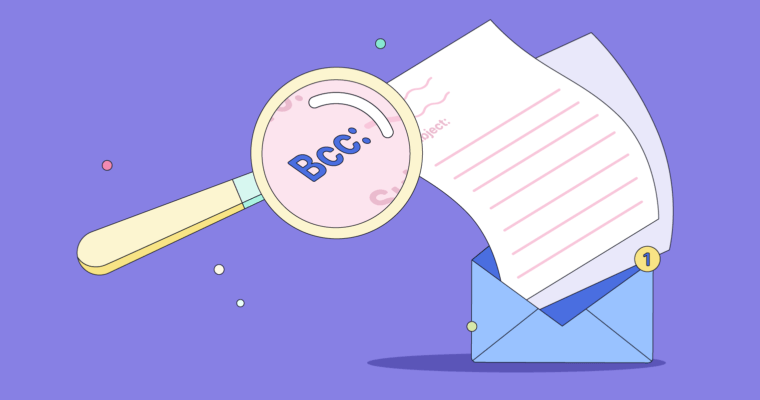
“Bcc” is a way to send people a copy of an email while keeping their email addresses hidden from the rest of the recipients.
Understanding bcc is part of basic email etiquette. While you might not use the bcc function often, it’s good to know how to use it, when to use it, and when not to use it.
Consider this your complete guide to using bcc in an email. We’ll look at how bcc came to be and share the best ways to use it. Open your email, and let’s dive in!
Table of contents
Where to find bcc when sending an email
What is bcc in an email?
“Bcc” stands for blind carbon copy. It’s similar to carbon copy (cc), which sends a copy of your email to anyone you add to the cc field in your email provider. Bcc sends a copy of your email to anyone in the bcc field but hides their email address from all other recipients. Bcc recipients won’t be able to use the reply-all function. No one who receives the email can see bcc recipients, and bcc recipients can’t see each other either.
Where did the term blind carbon copy come from? Before we used email, we used paper letters. When someone sent a letter to multiple people or kept a record of the letter for their files, senders used carbon paper to create a copy of the letter as they wrote it.
The result was called a carbon copy. Later, with the invention of email, carbon copy was abbreviated for the digital age to cc. Along with cc, email providers added bcc. The term “blind” within bcc refers to the fact that no one can see who’s bcc’d on an email, including other bcc’d recipients. Only the person who sent the email will know who was bcc’d.
You cannot send an email with only bcc’d recipients. An email address must be listed in the “to” field. To get around this, you can put your own email as the recipient. The same is true of the cc function.
When is bcc in an email used?
In general, if you don’t need to protect privacy, send an email to a large list of people, or copy someone on an email, you probably won’t need to use bcc. If you’re unsure whether you should use bcc, here are three ways you can use it and three ways you shouldn’t.
When should I use bcc in an email?
- To send a mass message: Whether you’re sending an email to family, friends, or your larger workplace, putting everyone in the bcc field will make it look like you’ve sent the email specifically to them.
- For privacy purposes: If you want to conceal someone’s contact information, or you don’t want recipients to know that you’ve shared the email with someone else, you can use the bcc field. You might include HR or your boss on an email for a paper trail or networking purposes. Be careful using it in this instance though. If you haven’t been told specifically that you need to do this, you should probably avoid it.
- To reduce lengthy email threads: If you’re sending a mass email or want to avoid a bunch of replies, putting everyone in the bcc field avoids both annoyances.
When should I not use bcc in an email?
The only thing worse than using tired phrases like “just following up . . .” is misusing bcc. We’ve rounded up the top three ways you shouldn’t use bcc, which might help you avoid embarrassing email mistakes.
- To make someone look bad: It’s inappropriate to bcc someone’s manager on an email to get them in trouble or make them look bad. There are professional ways to handle a situation like this.
- To eavesdrop: Bcc’ing someone on an email so they can eavesdrop is also bad email etiquette. It can lead to serious consequences, especially in work and academic settings.
- To avoid transparency: Using bcc to avoid being transparent is passive-aggressive communication. There are better and more direct ways to communicate your needs.
Where to find bcc when sending an email
The bcc function is located in a different place on each email service provider’s platform, but it’s usually just below or to the right of the “to” field. Some email providers hide the cc and bcc fields, so you may have to search for them the first time you want to use them.
Bcc in email examples
Here are three examples of scenarios when you may want to use the bcc feature.
1 You’re sending an invitation to a big party
You want to invite thirty friends and family members to a party, but you don’t want it to turn into a long email chain where everyone receives all the replies and responses—use the bcc field to add all your invitees’ email addresses. You might cc your partner or co-host and put your email address in the “to” field. You’ll get a copy of your email, and so will all your guests. Those who are invited will see that the email was sent to them and whomever you cc’d.
2 Your manager asks you to contact an external account
Perhaps your manager has asked you to send an email to a client whom they’ve handed off to you. In your first email to your new client, you may want to bcc your manager. In this instance, they’ll see exactly how you’ve reached out to the client, as well as any necessary information relating to the client’s transition.
3 Your coworker virtually introduces you to a new connection
In some instances, you may use email for networking. Your coworker could introduce you to a mentor by cc’ing you in an email sent to their address. You can move your coworker to the bcc field when you reply to the email. That way, your email chain becomes just you and the contact, but your coworker can see you’ve taken action on the email. Plus, your coworker’s inbox won’t fill up with your conversation with the contact.
Bcc in email FAQs
What does “bcc” in an email mean?
“Bcc” in an email means blind carbon copy. Bcc’ing someone on an email sends them a copy of the email but conceals their email address from all other recipients. It also removes the reply-all feature.
How does bcc in an email work?
To bcc someone in an email, add them to the bcc field when composing a new email, replying to an email you received, or forwarding an existing email within your email provider. Anyone in the bcc field will receive a copy of the email, but bcc will hide their email address from all other recipients, and they won’t be able to reply to everyone who received the email.
When should you use bcc in an email?
You should use bcc to send mass emails, conceal someone’s email address, or remove the reply-all feature. You should use it sparingly at work and ensure you’ve read up on email etiquette before you do.






